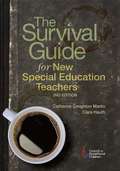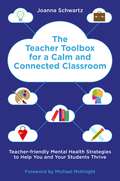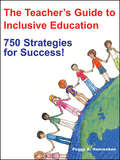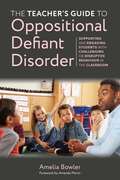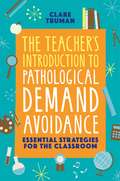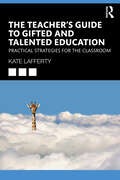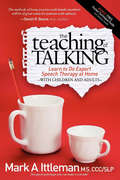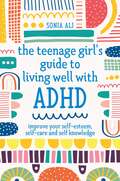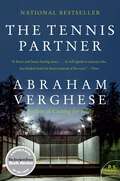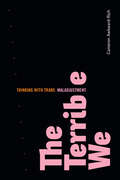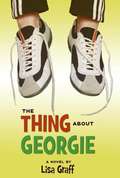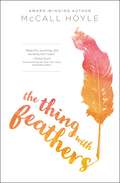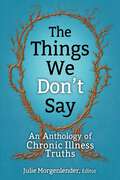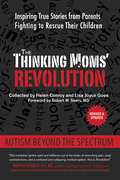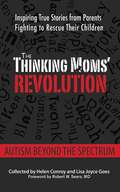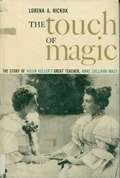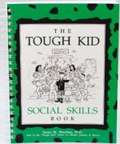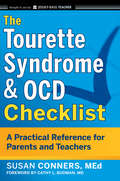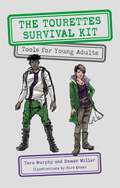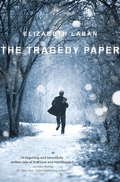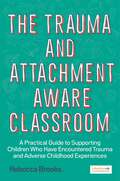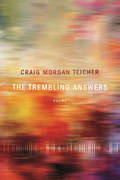- Table View
- List View
The Survival Guide for New Special Education Teachers
by Catherine Creighton Martin Clara HauthThe second edition of The Survival Guide for New Special Education Teachers is a must-have handbook for all new teachers both those in special education and those teaching in general education inclusive classrooms. The best part is the personal commentary and opportunities for reflection strategically placed throughout the guide. They make you feel like you have a mentor there to help you every step of the way.
The Tail of Max the Mindless Dog: A Children's Book on Mindfulness
by Florenza LeeAs a puppy Max’s tail is oftentimes hurt.Believing his tail to be the source of his pain, he sets out to catch and tie it in a knot. This leads to Max developing a habit of running in circles.Will Max learn a new more productive habit or will life pass him by?ABOUT THE TAIL OF MAX THE MINDLESS DOG, A CHILDREN’S BOOK ON MINDFULNESSIncorporates the Belly Breath, count of ten, and words of affirmation Adult and child are guaranteed to love this book. Mindfulness.
The Teacher Toolbox for a Calm and Connected Classroom: Teacher-Friendly Mental Health Strategies to Help You and Your Students Thrive
by Joanna SchwartzThe Teacher Toolbox for a Calm and Connected Classroom is a whole-child, whole-hearted approach to teaching, wellness, and student--teacher relationships.Chock-full of practical advice and brain-based tools from an experienced teacher and counselor, this book solves the question of how psychology and education can enrich and empower both teachers and students' wellness. Peppered with relatable anecdotes from the authors' experiences, the book deals with how to help unpack the' "invisible backpack" that both teachers and students bring into the classroom. Chapters are broken down to show how to practically address common issues such challenging behavior, social-emotional learning, trauma-informed education, attachment theory, mindfulness, mental health and much more. Each chapter outlines these common challenges but also provides an abundance of practical tools that can be used to help. Written accessibly, and with tools which are easy to implement, The Teacher Toolbox for a Calm and Connected Classroom is an indispensable guide for any teacher.
The Teacher's Guide to Inclusive Education: 750 Strategies for Success!
by Peggy A. HammekenThe ‘nuts and bolts’ of supporting an inclusive program or implementing a new one! Helping teachers meet all students’ learning needs in today’s diverse classrooms, this comprehensive resource shows how to establish an inclusive education program or enrich an existing one. The author provides strategies to assist students who are in special programs, who may be at risk, or who simply need additional support to be successful. Offering 108 reproducible forms and a complete resources section, this practical guide covers: Reading and written language accommodations Strategies for daily assignments and assessments Teaching strategies for mathematics Approaches for improving student behavior
The Teacher's Guide to Oppositional Defiant Disorder: Supporting and Engaging Students with Challenging or Disruptive Behaviour in the Classroom
by Amelia BowlerAre you looking for effective strategies for cooperating with your 'difficult' students? Are you struggling to find motivational tools for students that appear to be angry, rude, cruel, erratic, or stubborn?This book is an essential guide for school staff supporting students with Oppositional Defiant Disorder (ODD). Written by the author of The Parent's Guide to Oppositional Defiant Disorder: Your Questions Answered, this book debunks myths about ODD by providing psychiatric context, strength-based approaches and exploring the disorder through a holistic lens. Supporting teachers in building and maintaining healthy relationships with ODD students, the book equips educators with the skillset to understand their students, identify and avoid common obstacles and prepare their students to thrive in and outside of the classroom. Packed with easy-to-use handouts, questionnaires and printable exercises, this guide is perfect for teacher training and group activities.
The Teacher's Introduction to Pathological Demand Avoidance: Essential Strategies for the Classroom
by Clare TrumanThis essential guide for working with PDA pupils outlines effective and practical ways that teachers and school staff can support these pupils, by endorsing a child-led approach to learning and assessment.Beginning with an introduction to PDA and how it can affect the education experience, it is then followed by thoughtful, useful strategies school staff can implement to build a collaborative relationship with pupils and help them to thrive in the school environment. The activities presented aim to make children more comfortable and at ease, and therefore better able to learn. It covers key issues for children with PDA, such as sensory issues, preferred language and phrasing of demands, social skills, and recognising distressed behaviour. The chapter summaries and simple activities listed throughout make this a useful tool for busy teaching staff working with PDA pupils.
The Teacher’s Guide to Gifted and Talented Education: Practical Strategies for the Classroom
by Kate LaffertyThe Teacher’s Guide to Gifted and Talented Education: Practical strategies for the Classroom demonstrates ways to build and enhance your understanding of gifted learners with evidence-based, hands-on strategies to use in the classroom. Whether you are looking to improve your own practice or starting out as a Gifted Education coordinator in your school, this book will guide you through each step. Written by an author with extensive practical and research experience in the field, the book is informed by research and covers essential topics from theoretical frameworks to differentiation and innovative pedagogies. Each chapter includes a ‘Back to basics’ section, which provides the key information for those wanting just enough to get going, a ‘Taking it further’ section, which offers a more in-depth critique of the content and a ‘Chapter reflection’ which provides an opportunity to plan and set goals. This book offers a way of thinking about developing the talents of students, at all year levels, in all learning domains and in all contexts. It provides approaches that can be applied in the classroom immediately, or spark bigger conversations within the school. Filled with tips, strategies, checklists and templates, The Teacher’s Guide to Gifted and Talented Education is an essential resource for all educators, from early childhood through to secondary school.
The Teaching of Talking: Learn to Do Expert Speech Therapy at Home with Children and Adults
by Mark A. IttlemanIn this guide, a speech pathologist teaches readers the methods implemented to improve talking in others, so if need be, they can do therapy on their own. People with speaking difficulties are at the mercy of insurance companies who are determining how often and for how long speech therapy services should be delivered. It is also a disturbing reality that the likelihood for therapy frequency and length of care is contingent upon either the level of competence or comfort level of the speech-language pathologist or the financial policies of each institution. Often it has nothing to do with the severity or need for speech therapy. Our health care system is in no position to bankroll the long-term therapy needed by the many people who have moderate to profound speaking difficulties. The goal of The Teaching of Talking is to ensure that any loved one, caregiver, or speech-language pathologist is thoroughly knowledgeable in methods to help people improve talking since it is never known when the plug will be pulled on speech and language therapy services. Ittleman says, &“I see hundreds of people with speech and language difficulties each year. By reading and applying The Teaching of Talking, you will have the confidence to help your client or loved one, no matter what the insurance company or institution does. By learning to do what is in The Teaching of Talking, you will be more self-sufficient and will not have to rely on anyone to provide your loved one with expert speech therapy.&”&“The methods of home practice with family members will be of great value for patients with aphasia.&” —Daniel R. Boone, PhD, CCC/SLP
The Teenage Girl's Guide to Living Well with ADHD: Improve your Self-Esteem, Self-Care and Self Knowledge
by Sonia AliHave you ever been told you are chatty or fidgety at school?Do you have a constantly whirring mind? Do you 'tune out' and daydream or find it hard to pay attention?ADHD can impact your life in many ways. This positive, self-affirming guide will increase your knowledge about ADHD and empower you in your daily life.The chapters are full of tips, tricks and life hacks so you can better manage your time, harness your creativity, energy and enthusiasm, and make more time for fun! Reflection activities and quizzes will help you better understand yourself and learn strategies on how to manage the intense emotions of rejection sensitivity. You'll learn the fundamentals of great self-care and how to look forward to life beyond school.Learn how ADHD brains work, and tricky concepts like executive functioning. Quick chapter summaries let you pick which sections are most relevant to you right now, and the strategies and visuals are designed for ADHD brains and can be used with support from parents, mentors or teachers.The Teenage Girl's Guide to Living Well with ADHD gives you all you need to build on your strengths and overcome challenges to fully embrace who you are and live your best life.
The Tennis Partner: A Doctor's Story of Friendship and Loss
by Abraham VergheseAn unforgettable, illuminating story of how men live and how they survive, from Abraham Verghese, the acclaimed New York Times bestselling author of Cutting for Stone and The Covenant of Water, an Oprah's Book Club Pick.“Heartbreaking. . . . Indelible and haunting, [The Tennis Partner] is an elegy to friendship found, and an ode to a good friend lost.”—The Boston GlobeWhen Abraham Verghese, a physician whose marriage is unraveling, relocates to El Paso, Texas, he hopes to make a fresh start as a staff member at the county hospital. There he meets David Smith, a medical student recovering from drug addiction, and the two men begin a tennis ritual that allows them to shed their inhibitions and find security in the sport they love and with each other. This friendship between doctor and intern grows increasingly rich and complex, more intimate than two men usually allow. Just when it seems nothing can go wrong, the dark beast from David’s past emerges once again—and almost everything Verghese has come to trust and believe in is threatened as David spirals out of control.
The Terrible We: Thinking with Trans Maladjustment (ASTERISK)
by Cameron Awkward-RichIn The Terrible We Cameron Awkward-Rich thinks with the bad feelings and mad habits of thought that persist in both transphobic discourse and trans cultural production. Observing that trans studies was founded on a split from and disavowal of madness, illness, and disability, Awkward-Rich argues for and models a trans criticism that works against this disavowal. By tracing the coproduction of the categories of disabled and transgender in the United States at the turn of the twentieth century and analyzing transmasculine literature and theory by Eli Clare, Elliott DeLine, Dylan Scholinski, and others, Awkward-Rich suggests that thinking with maladjustment might provide new perspectives on the impasses arising from the conflicted relationships among trans, feminist, and queer. In so doing, he demonstrates that rather than only impeding or confining trans life, thought, and creativity, forms of maladjustment have also been and will continue to be central to their development.Duke University Press Scholars of Color First Book Award recipient
The Thing About Georgie
by Lisa GraffAs far as Georgie is concerned, everyone has a "thing" The thing about poodles is that Georgie Bishop hates to walk them. The thing about Jeanie the Meanie is that she would rather write on her shoe than help Georgie with their Abraham Lincoln project. The thing about Andy's nonna is that she kisses Georgie's cheeks and doesn't speak one word of English. The thing about Georgie's mom is that she's having a baby--a baby who will probably be taller than Georgie very, very soon. The thing about Georgie . . . well, what is the thing about Georgie?
The Thing with Feathers
by Mccall HoyleEmilie Day believes in playing it safe: she’s homeschooled, her best friend is her seizure dog, and she’s probably the only girl on the Outer Banks of North Carolina who can’t swim.Then Emilie’s mom enrolls her in public school, and Emilie goes from studying at home in her pj’s to halls full of strangers. To make matters worse, Emilie is paired with starting point guard Chatham York for a major research project on Emily Dickinson. She should be ecstatic when Chatham shows interest, but she has a problem. She hasn’t told anyone about her epilepsy.Emilie lives in fear her recently adjusted meds will fail and she’ll seize at school. Eventually, the worst happens, and she must decide whether to withdraw to safety or follow a dead poet’s advice and “dwell in possibility.”From Golden Heart award-winning author McCall Hoyle comes The Thing with Feathers, a story of overcoming fears, forging new friendships, and finding a first love, perfect for fans of Jennifer Niven, Robyn Schneider, and Sharon M. Draper.
The Things We Don't Say: An Anthology of Chronic Illness Truths
by Julie MorgenlenderChronically ill people don't always talk about it. Until now. Spanning different ages, ethnicities, genders, sexual orientations, and diagnoses, forty-two authors from around the world open up in fifty true stories about their chronic illnesses and their search for answers, poor treatment by doctors, strained relationships with loved ones, self-doubt, and more. They share the warmth of support from family and friends, the triumph of learning coping mechanisms, and finding ways to live their dreams. These stories are honest, raw, and real, and if you have chronic illness, you will find comfort and companionship in these pages. For everyone else, if you have ever wanted to know more about your loved one's experience with chronic illness but didn't want to ask the wrong questions, this book will have some answers, and more importantly lead you to a new-found understanding.
The Thinking Moms' Revolution: Autism Beyond the Spectrum: Inspiring True Stories from Parents Fighting to Rescue their Children
by Helen Conroy Lisa Joyce GoesThe Thinking Moms’ Revolution (TMR) is a group of twenty-three moms (and one awesome dad) from Montana to Malaysia who all have children with developmental disabilities. Initially collaborating online about therapies, biomedical intervention, alternative medicine, special diets, and practicing professionals on the cutting edge of treatment approaches to an array of chronic and developmental disabilities such as autism, sensory processing disorders, food allergies, ADHD, asthma, seizures, PANDAS, and other related conditions, they’ve come together into something far more substantial. Here, collected by Helen Conroy and Lisa Joyce Goes, are the stories of the moms and their fights to recover their kids from autism and related disorders. With each chapter written by a different TMR member, they share how they discovered each other, what they learned from each other, and why it’s important to have close friends who understand what it’s like to parent a child with special needs. You’ll read about the Thinking Moms’ experiences, and learn how their determination and friendships have become a daily motivation for parents worldwide.
The Thinking Moms' Revolution: Autism beyond the Spectrum: Inspiring True Stories from Parents Fighting to Rescue Their Children
by Robert W. Sears Helen Conroy Lisa Joyce GoesThe Thinking Moms’ Revolution (TMR) is a group of twenty-three moms (and one awesome dad) from Montana to Malaysia who all have children with developmental disabilities. Initially collaborating online about therapies, biomedical intervention, alternative medicine, special diets, and doctors on the cutting edge of treatment approaches to an array of chronic and developmental disabilities, such as autism, sensory processing disorders, food allergies, ADHD, asthma, and seizures, they've come together into something far more substantial. Suspecting that some of the main causes may be overused medicines, vaccinations, environmental toxins, and processed foods, they began a mission to help reverse the effects. In the process, they became a tight-knit family dedicated to helping their kids shed their diagnoses. Here, collected by Helen Conroy and Lisa Joyce Goes, are the stories of their fights to recover their kids from autism and related disorders. With each chapter written by a different TMR member, they share how they discovered each other, what they learned from each other, and why it’s important to have close friends who understand what it's like to parent a child with special needs. You'll read about the their experiences, and learn how their determination and friendships have become a daily motivation for parents worldwide.
The Three Christs of Ypsilanti: A Psychological Study
by Milton RokeachIn 1960 psychologist Milton Rokeach staged an unusual experiment to study questions of identity and delusional thinking. He brought together three chronic schizophrenic patients at Ypsilanti State Hospital in Michigan, each of whom believed himself to be Jesus Christ. For over a year the research team and the three patients met daily. This book is an account of what occurred in and outside these meetings as the three Christs struggled to adjust their concept of themselves against the fact that others claimed the same identity. Although some of the researchers' methods seem questionable by today's standards, this is a fascinating look at how beliefs are formed and sustained, and a poignant portrayal of three deeply troubled human beings.
The Tomoka Mystery
by Diane SawyerLilli Masters agrees to accompany Detective Zack Faraday to Florida as his "emergency girlfriend" to hunt down a gang of thieves and get Zack's sister off his back. But Zack is surprised when Lilli, against orders from the FBI, solves the case and saves his sister's life.
The Touch of Magic
by Lorena A. HickokThe story of Helen Keller's great teacher, Anne Sullivan Macy
The Tough Kid Social Skills Book (Tough Kid Series)
by Susan Sheridan Tom OlingFocuses on teaching social skills to the student who displays excesses in noncompliance and aggression and deficits in self-management.
The Tourette Syndrome & OCD Checklist
by Susan ConnersUp-to-date, reliable information about Tourette Syndrome and related disorders for teachers and parentsChildren with TS are often teased and punished for the unusual yet uncontrollable symptoms of their disorder. Academic failure is common. The Tourette Syndrome/OCD Checklist helps parents and teachers to better understand children and youth with TS and/or OCD and provide the support and interventions these children need. Presented in a simple, concise, easy-to-read checklist format, the book is packed with the latest research, practical advice, and information on a wide range of topics.Provides a wealth of information on Tourette Syndrome, Obsessive-Compulsive Disorder, and related conditionsIncludes strategies for discipline and behavior management, advice on supporting and motivating kids with TS and OCD, homework tips, and moreShows how to educate peer students about TS and OCDLoaded with practical information, strategies, and resources, this book helps parents and teachers to better understand Tourette Syndrome and OCD and shows how every individual can reach their potential in school and in life.
The Tourettes Survival Kit: Tools for Young Adults with Tics
by Tara Murphy Damon MillarStruggling to manage your tics in the classroom? Worried about your tics in a job interview or on a first date? This survival kit will give you the tools to survive and thrive in every location - at home, school, work or out with friends. Presenting everyday situations, from schools and exams through to driving and dates, this guide provides simple solutions to common problems and concerns. Dr Tara gives her top tips for managing tics, alongside behavioural therapy techniques for stress management and strategies for coping with commonly co-occurring conditions such as ADHD, OCD and anxiety.
The Tragedy Paper
by Elizabeth LabanPerfect for fans of Thirteen Reasons Why and Looking for Alaska, Jennifer Weiner, #1 New York Times bestselling author, calls Elizabeth LaBan's The Tragedy Paper "a beguiling and beautifully written tale of first love and heartbreak." It follows the story of Tim Macbeth, a seventeen-year-old albino and a recent transfer to the prestigious Irving School, where the motto is "Enter here to be and find a friend." A friend is the last thing Tim expects or wants--he just hopes to get through his senior year unnoticed. Yet, despite his efforts to blend into the background, he finds himself falling for the quintessential "It" girl, Vanessa Sheller, girlfriend of Irving's most popular boy. To Tim's surprise, Vanessa is into him, too, but she can kiss her social status goodbye if anyone ever finds out. Tim and Vanessa begin a clandestine romance, but looming over them is the Tragedy Paper, Irving's version of a senior year thesis, assigned by the school's least forgiving teacher. Jumping between viewpoints of the love-struck Tim and Duncan, a current senior about to uncover the truth of Tim and Vanessa, The Tragedy Paper is a compelling tale of forbidden love and the lengths people will go to keep their secrets.
The Trauma and Attachment-Aware Classroom: A Practical Guide to Supporting Children Who Have Encountered Trauma and Adverse Childhood Experiences
by Rebecca BrooksOffering teachers and other education staff guidance on how to work with children who have experienced trauma, this practical book is full of hands-on tips and guidance as to the most effective ways they can offer support. It covers a wide breadth of topics such as behavioural issues and home and school co-operation.
The Trembling Answers (American Poets Continuum)
by Craig Morgan TeicherWINNER OF THE 2018 LENORE MARSHALL POETRY PRIZEAn extension of and a departure from previous explorations of family and art, these poems delve boldly into tangled realities of fatherhood, marriage, and poetry. Dealing with the day-to-day of family life—including the alert anxiety and remarkable beauty of caring for a child with cerebral palsy—these personal narratives illuminate the relationship that exists between poetry and a life fiercely lived.
